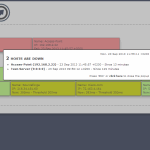 One year ago, I had published Whoisup v0.1, a script that monitors hosts via ICMP and shows the status in a web page. The script had obtained a good success, so I have decides to continue the WhoisUP project.
One year ago, I had published Whoisup v0.1, a script that monitors hosts via ICMP and shows the status in a web page. The script had obtained a good success, so I have decides to continue the WhoisUP project.
The version 0.2 has several improvements:
- Fixed some bugs in the core.php script and in the CSS file
- Added the warning latency value
- Added the width index page
- Added the maintenance mode
- Added the compact view
- Added the the core.php check
Below a brief analysis of these improvements:
- Fixed some bugs in the core.php script and in the CSS file: the script is more stable and require less client resources.
- warning latency value: One of the main improvements of the version o.2 is the warning value; if the host latency exceeds the warning value (in milliseconds) the cell will change the color: from green to canary yellow. This time value can be defined in global mode (for all devices) or can be customized for each host.
- width index page: it is possible define the max width (in pixel) for the index page.
- maintenance mode: this mode is useful when it is required to plan some critical activities, like device reload, IOS or operating system upgrade. In this way, the script works again, but all alerts (syslog, sound, popup or mail) are suspended.
- compact view: in this mode it is possible see a cumulative statistics: the numbers of host down/host up/host in warning. If the popup alert is enabled the page will show also the list of the host down/host in warning.
- core.php check: with this feature the index page will advise you if the core.php is stopped.
Below a video explains how to configure and use WhoisUP
Requirements:
- WEB Server (Apache, ISS, …)
- PHP 5 >= 5.1.0
- NMAP 6.x
The WhoisUP installation is quick and easy:
- Unzip the file (https://sourceforge.net/projects/whoisup/files/whoisup-0.2.zip/download) and place them on your webserver
- Set the ‘TMP’ and ‘conf’ folders to chmod 777 (on *nix systems) or to writable permission (on Windows systems)
- Set the files into ‘conf’ and ‘TMP’ folders to chmod 777 (on *nix systems) or to writable permission (on Windows systems)
- Go to the page htttp://[name-of-your-host]/whoisup/admin.php
- Login with the default key: ‘whoisup‘
- Compile the fields and change the secret key
Enable the core.php script in background:
After the WhoisUP installation it is required to launch the core.php script. This script is the core of the software, so without it, WhoisUP it will never work! You have two choises to enable the script in background
- Call the core.php script using the php command line with administrative/root privileges; for instance:
php \var\www\html\whoisup\core.php [your-secret-key] - Call the core.php using a browser (Explorer, Chrome, Firefox, …); for instance open the page
http://[name-of-your-host]/whoisup/core.php?secret=[your-key]
This is the worst method, because the webserver must have administrative/root privileges.
Some screenshots:
Syntax format:
- The ‘EmailToField’ list must follow this syntax:
test@nospam.com ciscozine@mydomain.com whoisup@nospam.com
- The IP address list must follow this format: [host-ip] # [host-name]
For instance:192.168.1.1 # my-route 8.8.8.8 # google-dns 123.123.123.123 # test-host
If required, you can customize the host latency (in milliseconds) for each host; for instance:
192.168.1.1 # my-route # 100 8.8.8.8 # google-dns 123.123.123.123 # test-host # 200
In this example, the 8.8.8.8 host has the default latency value (defined in the admin page), while the other two hosts have a custom latency value.
Remember:
- If you stop the core.php script, you will not receive any message (mail, sound or syslog message)
- The index page is only used to see the the host status. It is not needed open the index page to receive mail or syslog message.
Official Page: http://whoisup.sourceforge.net/




can we use this application to test in house web based or normal application performance testing
The software test only if hosts are reachable or not